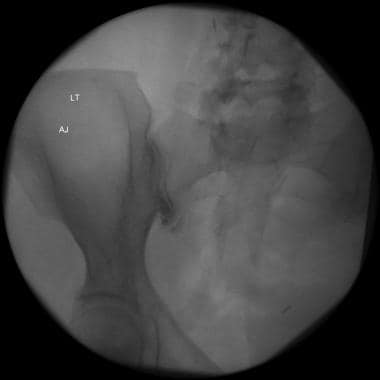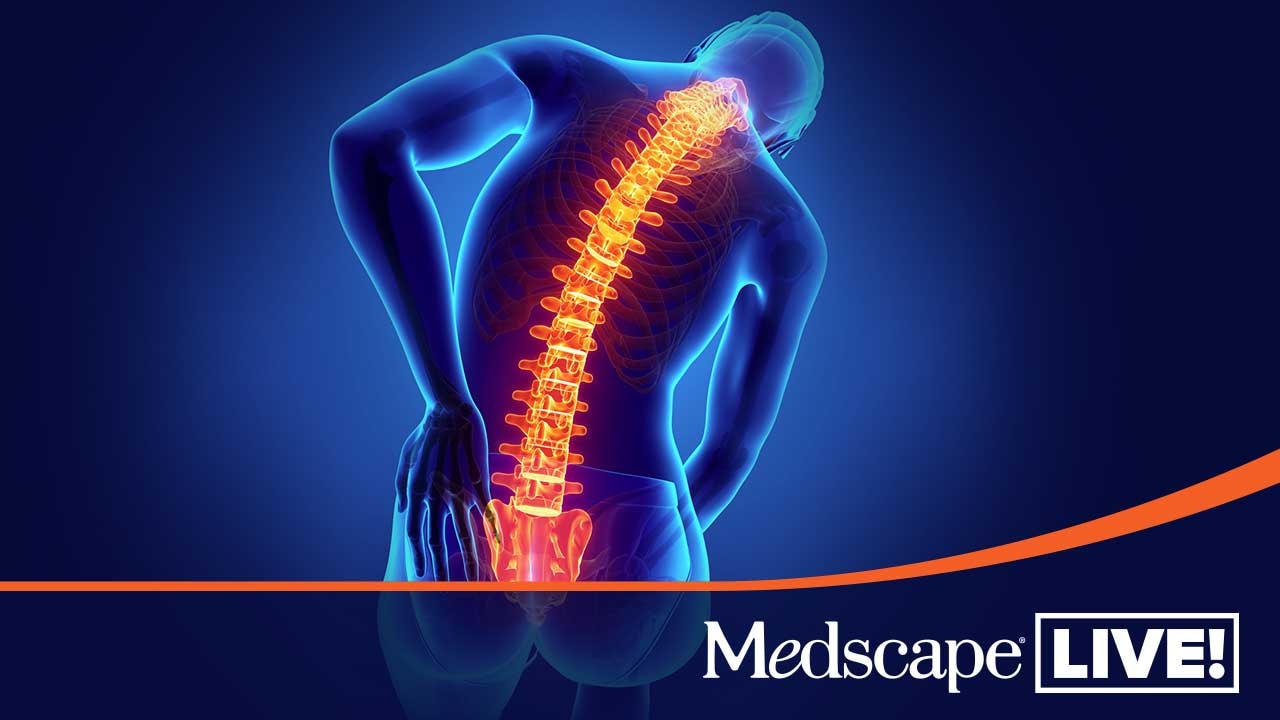Practice Essentials
Most of the US population will have low back pain at some point in their lifetime, with up to about a quarter of the population experiencing it within the past 3 months. [1] In addition, lower back pain is one of the most prevalent sports maladies, affecting athletes in nearly every sport. Diagnosing the cause of a back injury is quite difficult and challenging because multiple structures in the lower back region can cause pain. However, an accurate diagnosis is paramount to providing successful treatment of the spine injury.
Although still somewhat controversial, the sacroiliac joint (SIJ) is generally accepted as an anatomic structure within the lumbar complex that if injured can be a cause of lower back pain. Mechanical dysfunction, inflammation, infection, trauma, and degeneration all have been attributed to the SIJ. Once the diagnosis of SIJ injury is established, specifically directed treatment can lead to satisfying results. (See the image below.) This article discusses the diagnosis, management, and rehabilitation of sacroiliac injuries and pain.
Epidemiology
United States statistics
The incidence of lower back pain in humans parallels the incidence of the common cold, with a lifetime rate approaching 95%. Goldwaith and Osgood first discussed the possibility that SIJ injury could cause low back pain as early as 1905. [2] In the decades since then, several attempts have been made to establish the prevalence of SIJ syndrome in persons with back pain, and the results of these reports vary widely.
Schwarzer et al remarked that "the prevalence of sacroiliac pain would appear to be at least 13% and perhaps as high a 30%" in patients with low back and buttock pain. [3] Bernard and Kirkaldy-Willis reported the prevalence rate to be 22.5% in 1293 patients with back pain. [4]
There is a bimodal distribution with two peaks—younger adults following sporting injury and pregnancy and older adults from degeneration. Both genders and people of all races present with SIJ joint dysfunction. [5]
Functional Anatomy
The SIJ is a true diarthrodial joint that joins the sacrum to the ilium in the posterior pelvis. [6, 7, 8] In this joint, hyaline cartilage on the sacral side moves against fibrocartilage on the iliac side. The joint is generally C shaped with 2 lever arms that interlock at the second sacral level. The joint contains numerous ridges and depressions, indicating its function for stability more than motion. However, studies have documented that motion does occur at the joint; therefore, slightly subluxed and even locked positions can occur. [3, 9] The joint acts as a shock absorber by dissapating vertical forces of the spine and transmits them to the hips and lower extremities. [10]
Stability is provided by the ridges present in the joint and by the presence of generously sized ligaments. The ligamentous structures offer resistance to shear and loading. The deep anterior, posterior, and interosseous ligaments resist the load of the sacrum relative to the ilium. More superficial ligaments (eg, sacrotuberous ligament) react to dynamic motions (eg, straight-leg raising during physical motion). The long dorsal sacroiliac ligament can become stretched in periods of reduced lumbar lordosis (eg, pregnancy).
Many large and small muscles have relationships with these ligaments and the SIJ, including the piriformis, biceps femoris, gluteus maximus and minimus, erector spinae, latissimus dorsi, thoracolumbar fascia, and iliacus. Any of these muscles can be involved with a painful SIJ. As a true joint, the SIJ is a pain-sensitive structure richly innervated by a combination of unmyelinated free nerve endings and the posterior primary rami of L2-S3. The wide possibility of innervation may explain why pain emanation from the joint can manifest in so many various ways, with different and unique referral patterns for individual patients.
The sacrum can move with respect to the ilium in 6 degrees of freedom, although this motion is minimal, and the joint's hypermobility or hypomobility may cause pain emanating from the joint region. Sexual dimorphism exists in the pelvis. Men tend to have a relatively long and narrow pelvis, with a longer and more conical pelvic cavity than that of women. These sex differences also reflect in the biomechanics of the joint: the female SIJ has higher mobility, and more stresses, loads, and pelvis-ligament strains, compared to the male SIJ. [11]
Sport-Specific Biomechanics
The function of the SIJ is to dissipate loads of the torso through the pelvis to the lower extremities and vice versa. The pelvis acts as a central base through which large forces are accepted and dissipated. Although the main role of the joint is to provide stability, the SIJ has limited motion that allows it to dissipate and transfer significant loads and stresses. Studies by Weisel indicate that most movement occurs when rising from the sitting to the standing position. However, the amount of motion is small, making assessment of sacroiliac motion during physical examination quite difficult. Selvik suggested that hyperextension produces the greatest degree of motion (2° on average, with only minimal translation of 0.5-1.6 mm).
If the motion in the pelvis is asymmetric, then dysfunction can occur. Some conditions that cause asymmetric motion include leg-length inequalities, a unilaterally weak lower limb (eg, polio), tight myofascial structures (eg, iliopsoas), and scoliosis. Hip osteoarthritis can lead to leg-length shortening and SIJ pain.
Women may be at increased risk for SIJ problems because their broader pelvises, greater femoral neck anteversion, and shorter limb lengths lead to different, possibly predisposing, biomechanics. In addition, pregnancy often leads to stretching of the pelvis, specifically targeting the sacroiliac ligaments and possibly leading to dysfunction, hypermobility syndromes, and chronic pain.
Innervation
The nerve supply of the SIJ originates from multiple lumbosacral root levels with partial innervation from L2 (anterior joint) to S3 (posterior joint). Because the root innervation can vary so widely, the pain referral patterns from primary sacroiliac pain can also vary. Fortin et al interviewed multiple patients documented to have sacroiliac pain by anesthetizing the joint with lidocaine injections under fluoroscopic guidance. [12, 13] He found referral patterns ranging from localized buttocks pain to frank radicular leg pain and many other descriptions in between.
Referred pain maps from SIJ dysfunction extend in the L5-S1 nerve distributions, commonly seen in the buttocks, groin, posterior thigh, and lower leg with radicular symptoms. However, this pain distribution demonstrates extensive variability among patients and bears strong similarities to discogenic or facet joint sources of LBP. [1]
Anterior innervation of the sacroiliac joint is from the ventral rami of the L5 to S2 nerve roots. The lateral branches of the dorsal rami of the S1 to S3 nerve roots innervate the posterior part. [5]
Pathophysiology
From an anatomical perspective, pathologic changes and injuries specific to different SIJ structures can result in SIJ pain. These changes include, but are not limited to, capsular and ligamentous tension, hypo- or hypermobility, extraneous compression or shearing forces, micro- or macro-fractures, soft tissue injury, and inflammation. [11] The SIJ becomes unstable when ligamentous laxity occurs, especially the interosseous and posterior ligaments. The primary mechanism of SIJ injury is a combination of axial loading and abrupt rotation.SIJ instability can also be a result of repetitive microtrauma. [10]
Etiology
Many patients state that their pain began spontaneously, whereas others can cite a specific inciting event. Bernard and Kirkaldy-Willis reported that 58% of patients diagnosed with SIJ pain based on clinical examination findings had some inciting traumatic injury. [4]
Many risk factors are associated with lower back pain, and many are directly associated with lumbar disk injury. These include, but are not limited to, smoking, poor physical condition, positive family history, and occupational lifting.
Factors that specifically increase the likelihood of mechanical injury to the SIJ have not been identified. Pregnancy is one particular condition attributed to SIJ dysfunction.
In the authors’ experience, certain biomechanical or muscle length imbalances may ultimately predispose a person to sacroiliac dysfunction and pain. Likely, this is a result of altered gait patterns and repetitive stress to the SIJ and related structures. These conditions exist in persons with leg-length inequality, scoliosis, a history of polio, poor-quality footwear, and hip osteoarthritis.
Other etiologies of SIJ pain may be spondyloarthropathy, infection, and prior lumbar fusion. [5]
Prognosis
Sacroiliac injury has an excellent prognosis for full recovery. Whereas most studies suggest 80% of people with a lower back injury significantly improve within 2 weeks, no scientific studies show any stratification into diagnostic groups (ie, SIJ injury vs disk injury vs piriformis injury).
If the correct diagnosis is made, utilizing a combination of history, multiple physical examination manuevers, and appropriate imaging or diagnostic procedures, a majority of patients can achieve adequate pain relief. In refractory cases, however, minimally invasive SI fusion is an option with variable results and a plethora of techniques utilized for SI fusion. [5]
Complications
Complications arise more from missed alternative causes of back pain than from any mechanical damage to the joint. Systemic conditions (eg, AS, Crohn-related arthritis) can cause future problems. Missed stress fractures to the hip could progress to a complete fracture. Finally, overlooked malignancy is a rare but real possibility.
Other complications can occur in athletes not fully rehabilitated. Muscle imbalances may persist and put the athlete at risk for reinjury or future injury to another structure. Finally, with any back injury, an inherent risk exists that the pain may become chronic. Excessive rest can often lead to adaption of a deconditioned state or sick role. These mechanical spine conditions must be identified early and rehabilitated aggressively to reduce this complication.
Patient Education
Patient education is essential to achieving good outcomes. Patients can be informed that their SIJ pain is considered a benign condition, which, in most cases, improves with time and conservative treatments. Encourage them to resume physical activity as soon as possible to prevent deconditioning. Also encourage them to immediately enlist the help of a physical therapist to assist with therapeutic exercise. Home exercise programs are essential to help prevent reinjury and can be provided by a physician, chiropractor, or physical therapist.
-
Flouroscopically guided sacroiliac joint injection. Contrast seen throughout the joint.









